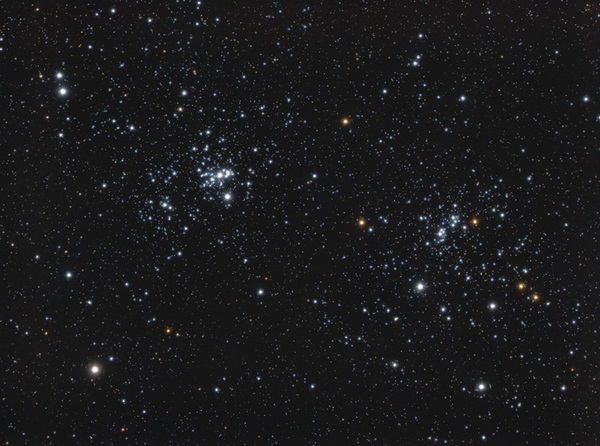The Sky This Week from March 27 to April 3 – Astronomy Magazine
Perseus Double Cluster Delights
NGC 869 and NGC 884 are two young star clusters in the constellation Perseus. These targets are easy to capture with binoculars or a small telescope; from dark sites, you may be able to spot them unaided.
Ewan Hobbs (Flickr)
The waxing Moon is still less than 12 percent lit and sets shortly after 10 P.M. local time, freeing the deep sky for observers who would rather stay up late than wake up early. After darkness falls, search out the Perseus Double Cluster, also known as NGC 869 and NGC 884 or h and Chi (χ) Persei. This sparkling pair of open clusters is sometimes visible to the naked eye from a dark site, but is also easy to find with binoculars or a small scope.
Many objects appear close to each other in the sky only because of projection effects, but these two young groups of stars are physically close in space as well, only a few hundred light-years apart. Astronomers believe both may have formed from the same massive star-forming cloud of gas and dust, although h (which lies west of Chi) is about 2 million years older than its sibling.
Saturday, March 28
The Moon passes 7° south of the planet Venus at 7 A.M. EDT this morning. Tonight, you can catch the pair — still just 8° apart — more than 40° above the western horizon at sunset and sinking slowly as the night progresses. The Moon is now 18 percent lit, while Venus is almost 50 percent illuminated.
Curious comet hunters may want to try finding C/2019 Y4 (ATLAS), which is brightening dramatically as it speeds closer to the Sun. Still months from rounding our star at perihelion, the comet is currently at magnitude 8 and located in Ursa Major, about 63° north of Venus. The bright star Capella lies roughly halfway between the two, forming the point of a long, low triangle connecting the three.
Sunday, March 29
Eighth-magnitude Vesta slips past the crescent Moon this morning in Taurus the Bull. At 3 A.M., the two are separated by just 0.2°, but below the horizon. By sunset, the two are much farther apart — 8° — and Vesta now hangs about halfway between the Moon and Venus in the west, just 7° southeast of the Pleiades (M45). East of the asteroid is the familiar v shape of the Hyades Cluster as well as ruddy, bright Aldebaran, the eye of Taurus.
Monday, March 30
Rise early this morning to find Scorpius the Scorpion and his famous red-hued heart, Antares, skimming near the southern horizon in the hours before sunrise. Magnitude 1 Antares’ name means “rival of Mars,” indicating just how easily the bright star can be mistaken for the Red Planet. In fact, turn to the southeast and you’ll see the real deal: Mars shines just a bit brighter — magnitude 0.8 — and lies clustered with Saturn less than 2° to its north and Jupiter about 5.5° to the west. The Red and Ringed Planets are inching ever closer, and their big meeting is just a day away.






